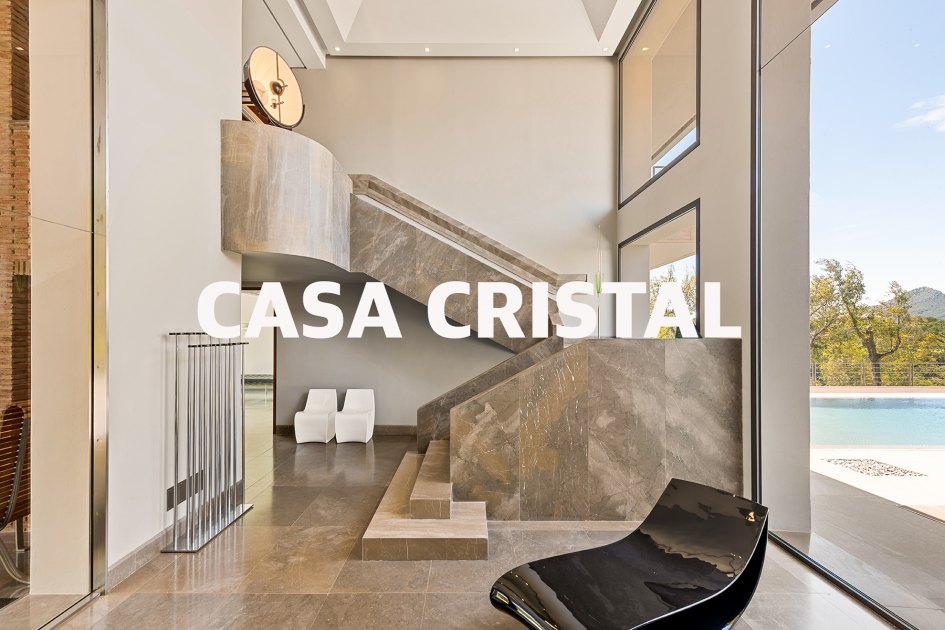The Architect Series 1: Casa Cristal by Juan Salvador Shvartzberg

Welcome to The Archiect Series. Join us in this first episode, where renowned Marbella-based architect Juan Salvador Shvartzberg takes us through one of his creations, Casa Cristal, in La Zagaleta Golf & Country Club, an exclusive residential estate in the Marbella area of Southern Spain. Juan Salvador Shvartzberg reveals how he forged the homes' relationship between architecture, landscaping and internal spaces, creating a home that is a testament to how good architecture is timeless.
Casa Cristal, La Zagaleta - Timeless Architecture with Juan Salvador Shvartzberg

Video Transcription
We find ourselves in "Casa Cristal" within the residential estate of La Zagaleta. A very special estate, probably one of the most important in Europe. A wonderful environment surrounded by mountains.
I’m Juan Salvador Shvartzberg and my studio bears my name; it’s called Juan Salvador Shvartzberg Architecture.
Right now, we’re in one of the houses that I’ve designed, which is almost 20 years old.
When I met the clients, they wanted something different.
The concept of “different” wasn’t completely clear, but I was surprised, and excited on the other hand, about the idea of being able to build a house in La Zagaleta that was “different”.
The concept of “different” was to create an interior with seamless spaces, but at the same time with an architecture of volumes which were contemporary. I’m in favor of tiles, not because of a folkloric reason, but because I believe that there are historical elements that have been passed down to us during centuries and that are worthy of respect. You can make a contemporary house with tiles and with modern interiors.
The clients helped a lot during the whole process, choosing materials that blended well with the idea of contemporaneity and, at the same time, warmth. For example, the floors are made of honed Sierra Elvira. Each room has special pieces and a very big contrast with the carpentry, which is made of cherry wood to give it warmth.
From the outset the clients wanted a gray house, which is fashionable now, but in those days, it wasn’t very fashionable and seemed quite strange. The carpentry is gray, the floor is gray, the ceilings are gray, materials such as stainless steel predominate… The spaces are seamless, but clean, clear, with very large windows.
In this house there are two elements that are very particular. First of all, the pool is right next to the house. On the one hand, this was due to technical reasons, given the type of foundation that had to be made, but on the other hand, to give the house a connection with the water.
The windows of the living room open and there’s the pool. The idea of not having floor and instead having water seemed very interesting to me. Secondly, very rarely does one have the possibility of connecting the living room with the basement to take advantage of part of the basement as a continuation of the living room (which in this case is a library and a television room or home cinema). This living area, which is kind of a semi-basement, is connected to an indoor pool and therefore also has light through a large window which faces north with a beautiful grove.
The clients wanted materials that would express themselves. In the dining room we used the same mesh as the glass that divides the main bathroom with the bedroom, for texture and it has an extraordinary effect. It is like a ‘wall sculpture’.
The entrance door is made out of Corten steel, made in Germany. All stainless-steel railings are also made in Germany. The doors and cupboards are made of cherry wood.
There’s a connection between the basement’s lobby and the library, cinema room and indoor pool, and the solution we found to connect them, was to create a play of lights. Once lit, they throw beams of light in various directions and give the feeling of a spaceship connection.
The house has a cellar of a Roman character. The entire floor of the central vault is made of brick in the old fashion way, with self-supporting brick on brick (it doesn’t have a substructure that contains it).
The master bedroom wins the prize. The clients and I agreed to not include a terrace, because they weren’t interested in a terrace on the first floor. It has a bedroom area and a living room area and is connected to a bathroom, in which the bathtub is separated from the bedroom by a glass with a mesh, that prevents one from seeing into the bedroom or the bathroom but allows a glimpse of it. On the other hand, it creates a play of lights, because when the sun shines from the west, it sheds light on the bathroom and the mesh gives a very nice light effect.
When we began the design, the hall contained the staircase that leads to the first floor and my intention was to design a staircase that was also a sculpture. It is lined with the same Sierra Elvira material, a Sierra Elvira handrail that is embedded into the wall. It’s a handrail that, well at that time, we didn’t have LED lights and today we would have a LED strip inside the handrail. That handrail forms a material unit between the floor, the ceiling and the steps. It’s like a perfectly coordinated continuation of the floor.
I think this is a house that respects its environment, combining the idea of modernity with contemporaneity.
Pia Arrieta, 07 Feb 2023 - Architect Series - Property
Related Articles

Villa HG: A new benchmark for luxury villas in Marbella
5 min. read · Pia Arrieta

The Innovative Architecture of Casa Mashrabiya: An Interview with Studio MK27
7 min. read · Pia Arrieta

The Architect Series 4: Via Mar La Cerquilla by Cristina Yeregui
3 min. read · Pia Arrieta

Marcio Kogan: Architectural Visionary and his debut in Marbella
2 min. read · Pia Arrieta